Jul 19, 2016
Moodi Mahmoudi
Piggybacking on Next’s mission to #OccupyInnovation is a related idea of noteworthy heft. As we have already agreed that every employee on every level of an organization has the power to be an innovator, we no longer need focus on the “who” of innovation. Instead, we will turn our attention to where innovation shall occur within an organization.
Check out the following quote from iconic designer Marc Jacobs:

“Innovation is an evolutionary process, so it’s not necessary to be radical all the time.”
Makes sense. After all, according to analysis by Doblin and Deloitte, innovation almost never fails because of a lack of creativity, but rather a lack of discipline in its execution. Once that discipline is codified, embedded, and scaled, innovation never stops, and can be applied to every level of an organization — and for every type of initiative.
At Next we’re big fans of Bansi Nagji’s and Geoff Tuff’s “Innovation Ambition Matrix,” as represented below:

Source: Nagji, B., & Tuff, G. (2012). Harvard Business Review
Core is about the simple, creative tweaks to existing products meant for existing customers. These are innovations that will cause current operations to become more efficient and profitable. Innovating and transforming the core requires no external resources and is accomplished by those employees conducting the core, day-to-day business. The success rate of such innovations is high, and is therefore widely supported by profit and loss leaders of the core business line.
Adjacent focuses on conceiving natural extensions of your current business into business that is “new to the company.” These can be add-on services or complementary products the organization can provide that are related to the organization’s existing offerings and that aim to capture more value. This type of innovation is achieved by people in the core business line, leveraging their deep understanding of the organization’s core offering. These initiatives see teams collecting customer insights and needs that were previously overlooked.
Transformational involves disruptive innovations — those that will develop breakthroughs and moonshots for markets that do not yet exist.
These innovations are sparked by creativity that is triggered by technological paradigm shifts or drastic evolutions in customer expectations, behavior, or both. Such innovations disrupt the market and the organization’s existing business, bringing about deep transformation. As such, and due to Transformational innovations’ highly risky nature, they shall be undertaken on the edges — or sometimes outside — of the organization. Transformational innovations operate under very different risk conditions and metrics than the rest of the organization, and are led by different people than those leading the core business.
Considering all three levels of the Matrix are critical to ensuring that an organization doesn’t succumb to strategic myopia — to becoming blinded by current success and subsequently missing out on the rise of disruptive trends — or hyperopia — becoming so consumed by disruptions that incremental improvements that make the core business stronger and more profitable are overlooked.
Notice, then, the resource and time allocation prescribed for each type of innovation: 70 percent to Core, 20 percent to Adjacent, and 10 percent to Transformational.

Source: Nagji, B., & Tuff, G. (2012). Harvard Business Review
The Ambition Matrix is an interesting — and slightly varied — take on the classic “Three Horizons Framework” for innovation in enterprises. Take a look:

Source: McKinsey — Enduring Ideas
If Horizon Three (Transformational) is a visionary innovation, Horizon One (Core) is something simpler and more concretely tangible. Employees operating on Horizon Two (Adjacent) will work to develop new opportunities that extend the current business.
Together, the three horizons ensure that ascending the tiers of innovation is an assembly line-like process, easily and oft repeated. This allows for the future of an organization to be planned for, while simultaneously maintaining what is actively profitable.
Whatever your preferred model — the Matrix or the Horizons — both are excellent platforms on which to base and subsequently shape innovation. Once you hack in and begin to explore, you will find that your organization is constantly firing on all cylinders, and that innovation is an unceasing, unrelenting, and unstoppable force.
—
Contributing editor: Adam Kohut
Photo: Dako Huang



